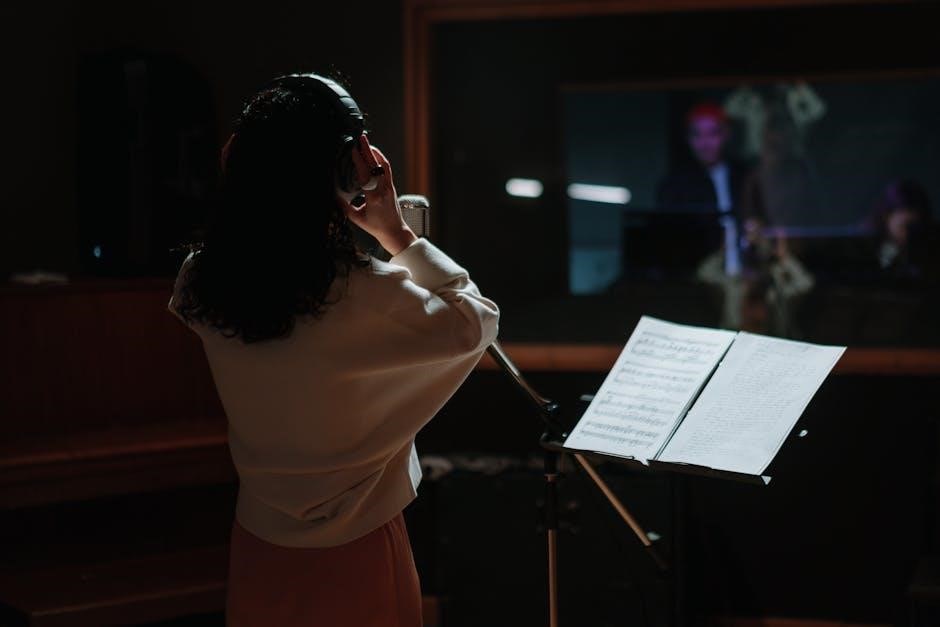Walt Whitman’s Song of Myself is a monumental poem from the 1855 edition of Leaves of Grass, celebrating individuality, democracy, and nature’s grandeur. Its 52 sections explore themes of identity, interconnectedness, and the divine, making it a cornerstone of American literature.
1.1 Overview of the Poem
Song of Myself is Walt Whitman’s magnum opus, comprising 52 sections and approximately 1,300 lines. First published in 1855 within Leaves of Grass, it is a celebration of the self, nature, and democracy. The poem explores themes of identity, interconnectedness, and the divine, written in free verse. Whitman’s expansive and inclusive style reflects his belief in the unity of all things. The poem has evolved through multiple editions, with the 1881 version being the final. Its enduring relevance lies in its exploration of individuality and the universal human experience, making it a cornerstone of American literature.
1.2 Historical Context of the 1855 Edition
The 1855 edition of Song of Myself emerged during a period of cultural and political upheaval in the United States. The mid-1850s saw rising tensions over slavery, westward expansion, and the impending Civil War. Whitman, influenced by transcendentalism and democratic ideals, sought to capture the spirit of American identity. The poem reflected the era’s emphasis on individualism and nature. Its unconventional free verse style challenged traditional poetry, aligning with the era’s push for social and artistic change. The 1855 edition was groundbreaking, setting the stage for Whitman’s lifelong revisions and cementing his poetic innovation.
1.3 Significance of the Poem in American Literature
“Song of Myself” is a cornerstone of American literature, celebrated for its revolutionary style and themes. It redefined poetry by breaking free from traditional forms, embracing free verse and a democratic voice. Whitman’s celebration of individuality and the interconnectedness of all beings resonated deeply, influencing generations of writers. The poem’s emphasis on democracy and the universal human experience solidified its place as a defining work of American identity. Its enduring relevance continues to inspire poets, scholars, and readers, making it a foundational text in literary studies and a testament to Whitman’s visionary genius.

Structure and Organization of “Song of Myself”
The poem is divided into 52 sections, reflecting Whitman’s free-verse style. It flows organically, with each section connecting to the next, creating a sense of unity and continuity.
2.1 The 52 Sections of the Poem
“Song of Myself” is structured into 52 sections, each varying in length and focus. These sections are not traditional stanzas but thematic units, exploring diverse aspects of life, nature, and identity. Whitman uses this structure to mirror the vastness and complexity of human experience, allowing the poem to flow organically. The sections often blend personal reflection with universal themes, creating a sense of intimacy and expansiveness. Over time, Whitman revised and expanded these sections, reflecting his evolving philosophy and artistic vision. The 52 sections ultimately form a cohesive celebration of democracy, nature, and the interconnectedness of all things.
2.2 Key Themes and Motifs
“Song of Myself” explores themes of democracy, individuality, and the interconnectedness of all life. Whitman celebrates the human body and spirit, embracing diversity and equality. Nature serves as a central motif, symbolizing the universe’s unity and the self’s place within it. The poem also reflects Whitman’s belief in the divine inherent in all things, blending spirituality with humanism. Recurring imagery, such as grass and the journey of the soul, reinforces these themes, creating a sense of continuity and shared experience. These motifs collectively express Whitman’s vision of a harmonious, democratic universe.
2.3 The Evolution of the Poem Across Editions
Walt Whitman continuously revised and expanded “Song of Myself” over nearly four decades, reflecting his evolving philosophy and poetic vision. The 1855 edition, the first, was concise and raw, while subsequent editions grew in complexity and depth. By the final 1892 “Deathbed Edition,” the poem had expanded to 52 sections, showcasing Whitman’s refined themes of democracy and unity. Each revision underscored his belief in the interconnectedness of all life, with additions enriching the imagery and symbolism. This evolution highlights Whitman’s dynamic creativity and his enduring quest for artistic and philosophical expression.
Major Themes in “Song of Myself”
“Song of Myself” explores themes of self-celebration, democracy, nature, and interconnectedness, reflecting Whitman’s vision of unity and the divine in all life.
3.1 Celebrating the Self and Individuality
Walt Whitman’s “Song of Myself” is a profound ode to the self, embracing individuality and the uniqueness of every person. The poem’s speaker, often seen as Whitman himself, celebrates the body, mind, and spirit, affirming the inherent worth of all beings. Through free verse, Whitman expresses self-love and unity with the universe, rejecting societal norms that diminish personal identity. This theme is central to his vision of democracy, where every individual’s voice matters. The poem’s emphasis on self-celebration remains a powerful message of empowerment and self-acceptance, resonating across generations and cultures.
3.2 Democracy and the American Identity
In “Song of Myself,” Walt Whitman envisions democracy as a vibrant, inclusive force that unites diverse voices. He portrays America as a land of equality, where individuals from all walks of life coexist harmoniously. Whitman’s celebration of democracy extends beyond politics, embracing cultural and social unity. His poem reflects the American identity as dynamic and multifaceted, emphasizing collective strength through diversity. By affirming the worth of every person, Whitman’s work embodies the democratic ideal, making it a cornerstone of American literary and cultural heritage. This vision continues to inspire reflections on democracy’s promise and challenges.
3.3 Nature and the Universe as Metaphors
Walt Whitman uses nature and the universe as metaphors to explore human existence and spirituality. He personifies natural elements, such as grass and stars, to symbolize life’s cycles and interconnectedness. The cosmos serves as a mirror for the self, reflecting the infinite and the divine. Whitman’s imagery of nature—like the vast ocean or the earth’s bounty—illuminates themes of unity, abundance, and the sacred. By equating the natural world with the human experience, he underscores the idea that all things are part of a larger, harmonious whole, transcending boundaries between the individual and the universe.
3.4 Humanism and the interconnectedness of All
Walt Whitman’s humanism shines through his portrayal of the interconnectedness of all beings, celebrating the inherent value of each individual. His poetry emphasizes unity, advocating for equality and democracy, where every person is seen as part of a larger whole. Whitman’s vision transcends social hierarchies, embracing diversity and promoting a sense of shared humanity. He illustrates this through imagery that connects the individual to the universe, suggesting that we are all part of an undivided, harmonious system. This theme underscores the idea that understanding ourselves is deeply linked to understanding others and the world around us.
Walt Whitman’s Style and Language
Whitman’s innovative free verse style revolutionized poetry, embracing a natural, conversational tone. His rich imagery and symbolism celebrated democracy, nature, and the human experience, reshaping poetic expression.
4.1 Free Verse and Its Revolutionary Impact
Walt Whitman pioneered free verse poetry in Song of Myself, rejecting traditional meter and rhyme. This bold departure from convention allowed for a fluid, natural expression, mirroring the democratic ideals he celebrated. His innovative structure gave poetry a new freedom, enabling a direct, personal voice. The poem’s lack of formal constraints emphasized individuality and spontaneity, reflecting Whitman’s belief in the equality of all experiences. This revolutionary style not only redefined poetry but also influenced future writers, making Whitman a cornerstone of modern poetic expression. His free verse remains a testament to his vision of art as a democratic, inclusive force.
4.2 Use of Imagery and Symbolism
In Song of Myself, Walt Whitman employs vivid imagery and symbolism to convey his themes of unity, democracy, and the interconnectedness of life. Natural imagery, such as grass, leaves, and the cosmos, serves as metaphors for the cycles of life, death, and rebirth. Symbols like the spider spinning its web illustrate the connection between the individual and the universe. Whitman’s imagery creates a sense of expansiveness, celebrating diversity and the beauty of the ordinary. These elements reinforce his vision of a harmonious, inclusive world, making the poem a rich tapestry of symbolic meaning.

4.3 The Role of the Speaker in the Poem
The speaker in Song of Myself is both personal and universal, representing Whitman himself while embodying a broader, collective voice. The speaker acts as a guide, inviting readers to explore themes of identity, nature, and democracy. Through their voice, Whitman celebrates individuality and unity, blurring the line between the self and the world. The speaker’s tone is intimate yet expansive, creating a sense of connection with the reader. This dual role reflects Whitman’s belief in the interconnectedness of all people and experiences, making the speaker a central, unifying force in the poem.

Critical Interpretations and Analysis
Scholars have explored the poem’s celebration of democracy, its exploration of human sexuality, and its spiritual themes, reflecting diverse critical approaches to Whitman’s enduring poetic masterpiece.
5.1 Psychoanalytic Perspectives on the Poem
Psychoanalytic readings of “Song of Myself” explore Whitman’s celebration of the self through the lens of subconscious desires and identity formation. Analysts interpret the poem as a reflection of the speaker’s inner world, where themes of unity and interconnectedness symbolize the integration of the psyche. The Oedipus complex and narcissistic tendencies are often highlighted, with Whitman’s embrace of the body and nature seen as a manifestation of repressed desires. Additionally, the fluidity of the self in the poem aligns with psychoanalytic notions of the fragmented ego, offering insights into the human condition’s complexity and the struggle for self-realization. This perspective enriches the poem’s deeper psychological dimensions.

5.2 Feminist and Queer Readings of “Song of Myself”
Feminist and queer interpretations of “Song of Myself” highlight Whitman’s celebration of the body and sexuality, challenging traditional gender norms. His embracement of fluid identities resonates with queer theory, particularly in lines like “Do I contradict myself? Very well, then I contradict myself.” Feminist scholars, however, critique the poem’s lack of direct representation of women’s voices. Despite this, Whitman’s emphasis on interconnectedness and democracy aligns with feminist ideals of equality. The poem’s exploration of desire and the self has also influenced LGBTQ+ literature, making it a foundational text for queer poetry and identity expression.
5.3 Ecocritical Insights into the Poem
Ecocritical readings of “Song of Myself” emphasize Whitman’s reverence for nature and its interconnectedness with humanity. The poem’s celebration of the natural world, as seen in its vivid imagery of landscapes and ecosystems, reflects a holistic view of life. Whitman’s famous metaphor of grass symbolizes democracy and the unity of all existence. His portrayal of nature as both intimate and expansive challenges anthropocentric perspectives, advocating for a harmonious coexistence with the environment. This eco-friendly vision resonates with contemporary environmental thought, making the poem a seminal work in ecocritical studies and a call to appreciate the Earth’s intrinsic value.

The 1881 Version of “Song of Myself”
The 1881 version, often called the “Deathbed Edition,” is the final and most complete edition of the poem, reflecting Whitman’s mature vision and artistic refinement.
6.1 Changes and Revisions from Earlier Editions
The 1881 edition of “Song of Myself” underwent significant revisions from earlier versions. Whitman refined the structure, polishing the free verse and enhancing thematic coherence. Certain controversial lines were softened or removed, while new sections were added to reflect his evolving philosophy. The poem’s focus on unity, spirituality, and the interconnectedness of all beings became more pronounced. This final version represents Whitman’s mature artistic vision, blending his earlier experimental style with a more reflective tone. It remains the most widely studied and celebrated version of the poem.
6.2 The Final Version’s Significance
The 1881 version of “Song of Myself” solidified its place as a cornerstone of American literature. It encapsulates Whitman’s mature vision, blending his earlier experimental style with refined philosophical insights. This edition is celebrated for its cohesive structure and thematic depth, offering a comprehensive exploration of democracy, nature, and human unity. Its innovative free verse and profound themes have made it a defining work in poetic history, continuing to inspire readers and writers alike with its enduring relevance and celebration of the human spirit.

Accessing “Song of Myself” in PDF Format
Walt Whitman’s Song of Myself is widely available in PDF format, accessible through libraries, online archives, and eBook platforms, offering convenient access to his seminal work.
7.1 Free PDF Downloads from Reliable Sources
Free PDF downloads of Walt Whitman’s Song of Myself are available from reliable sources like Project Gutenberg, ManyBooks, and Google Books. These platforms offer legally accessible versions of the poem, ensuring readers can explore Whitman’s masterpiece without cost. Many of these PDFs are scanned from original editions, preserving the historical integrity of the text. Additionally, some academic websites and libraries provide free downloads for educational purposes. Always verify the source’s credibility to ensure the PDF is accurate and free from copyright violations. These resources make Whitman’s work accessible to a global audience, fostering a deeper appreciation of his poetry.
7.2 Recommended Editions for Study
For a deeper understanding of Song of Myself, consider editions with annotations and introductions. The Norton Critical Edition and Oxford University Press versions are highly recommended, as they include critical essays and historical context. The 1855 and 1892 editions are also valuable, showcasing the poem’s evolution. Digital versions with hyperlinked notes and commentaries offer enhanced study tools. These editions provide scholars and readers with a comprehensive framework to explore Whitman’s work, making them ideal for academic and personal study. They ensure a richer appreciation of the poem’s complexity and significance.

Modern Adaptations and Tributes
Modern artists and writers continue to draw inspiration from Song of Myself, creating illustrated editions, graphic novels, and digital reinterpretations. These works honor Whitman’s legacy while introducing his poetry to new audiences, blending traditional themes with contemporary mediums to celebrate his timeless vision.
8.1 Illustrated Versions of the Poem
Illustrated versions of Song of Myself have become popular, blending Whitman’s poetry with visual art. Artists like Allen Ginsberg and Eric Drooker have created graphic adaptations, interpreting the poem’s themes. These editions often feature vibrant imagery, reflecting the poem’s celebration of nature, democracy, and the human spirit. Digital versions, including PDFs, incorporate interactive elements, enhancing the reader’s experience. Such adaptations ensure Whitman’s work remains accessible and engaging for modern audiences, while honoring his original vision of unity and individuality. These illustrated interpretations highlight the timeless appeal of Song of Myself in both print and digital formats.
8.2 Musical and Artistic Interpretations
Walt Whitman’s Song of Myself has inspired numerous musical and artistic interpretations, reflecting its universal themes. Composers like Ralph Vaughan Williams and John Adams have adapted sections into symphonies, capturing the poem’s lyrical essence. Visual artists, such as Robert Indiana, have created works influenced by its imagery. These interpretations highlight the poem’s emotional depth and relevance across mediums. Musical adaptations often emphasize the poem’s celebration of democracy and individuality, while artistic renditions explore its natural and spiritual motifs. Together, they expand Whitman’s legacy, making his poetry accessible to diverse audiences through creative expression.

Legacy and Impact of “Song of Myself”

Walt Whitman’s Song of Myself remains a foundational work in American poetry, influencing 20th-century movements and poets. Its celebration of democracy and individuality continues to inspire globally.
9.1 Influence on 20th and 21st Century Poetry
Walt Whitman’s Song of Myself profoundly shaped modern poetry, inspiring free verse and celebrating individuality. Poets like Allen Ginsberg and Sylvia Plath drew from its raw, personal style. The Beat poets embraced its democratic spirit, while confessional poetry reflected its emotional candor. Whitman’s focus on nature and the cosmos influenced ecopoetry, and his exploration of identity resonates in contemporary works. His legacy endures as a bridge between 19th-century Romanticism and modern experimentation, making him a cornerstone of poetic evolution in the 20th and 21st centuries.
9.2 The Poem’s Role in LGBTQ+ Literature
Walt Whitman’s Song of Myself has become a cornerstone of LGBTQ+ literature due to its celebration of the body, sensuality, and non-conformity. Whitman’s poetry, particularly its exploration of same-sex desire, resonated with queer readers and writers. His rejection of societal norms and embrace of fluid identity provided a powerful voice for marginalized communities. The poem’s themes of intimacy and self-acceptance have inspired LGBTQ+ poets like Adrienne Rich and Mark Doty, cementing its legacy as a foundational text in queer literary history and a symbol of liberation and self-expression.
9.3 Whitman’s Enduring Relevance in Contemporary Society
Walt Whitman’s Song of Myself remains deeply relevant in contemporary society, offering timeless themes of democracy, individuality, and the interconnectedness of all beings. His celebration of diversity, inclusivity, and the beauty of the human body resonates with modern discussions on equality and social justice. Whitman’s embrace of nature as a metaphor for life aligns with current ecological concerns. His poetry continues to inspire activists, artists, and thinkers, making him a foundational figure in modern culture. Whitman’s work reminds us of the importance of empathy, self-expression, and the pursuit of a harmonious society.
Walt Whitman’s Song of Myself remains a cornerstone of American literature, celebrating democracy, individuality, and interconnectedness. Its timeless themes continue to inspire, ensuring Whitman’s enduring legacy.
10.1 Summary of Key Points
Walt Whitman’s Song of Myself is a seminal work in American literature, exploring themes of democracy, individuality, and the interconnectedness of all life. The poem’s free verse style and rich imagery revolutionized poetry, breaking from traditional forms. First published in 1855, it underwent multiple revisions, reflecting Whitman’s evolving vision. The poem celebrates nature, the human condition, and the democratic spirit, making it a cornerstone of American identity. Its influence extends to modern poetry, LGBTQ+ literature, and ecological thought. Available in PDF, Song of Myself remains accessible for study and appreciation, ensuring Whitman’s legacy endures.
10.2 Final Thoughts on the Poem’s Significance
Walt Whitman’s Song of Myself is a groundbreaking work that continues to resonate deeply in contemporary culture. Its exploration of democracy, individuality, and the interconnectedness of all life remains timeless. The poem’s revolutionary free verse style and celebration of the human spirit have influenced countless writers and artists. As a foundational text in American literature, it challenges readers to embrace their uniqueness while recognizing the unity of existence. Whitman’s enduring relevance lies in his ability to transcend time, making Song of Myself a vital read for understanding both the past and the present.
